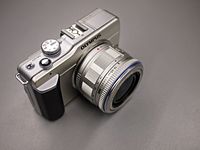- Olympus PEN E-PL1
-
Olympus Pen E-PL1 
Type Micro Four Thirds, interchangeable lens camera Sensor Four Thirds System 18.00 × 13.50 mm Live MOS Maximum resolution 4032×3024 (12.3 megapixels) Lens Micro Four Thirds System mount Flash Yes, also hot shoe allows for a variety of external flashes Shutter 1/2,000 to 60 s – 30 minutes bulb Exposure modes Program, shutter-priority, aperture-priority, manual Metering modes ESP multi patterned, Center-weighted average (60%), Spot (2%) Focus areas 11 area contrast detect auto-focus, selectable Focus modes Single, continuous, manual Continuous shooting 3 frame/s Viewfinder live preview, optional optical viewfinder (Olympus VF-1) and electronic viewfinder (Olympus VF-2) Rear LCD monitor 2.7" 230,000 pixel TFT LCD on screen with live preview Storage Secure Digital card Battery Li-ion 7,2V 1150mAh Dimensions 115 × 72 × 42 mm Weight 334 g (0.74 lb) Made in  China
ChinaThe Olympus PEN E-PL1, announced on 3 February 2010[1] is Olympus Corporation's third camera that uses the Micro Four Thirds mount after the Olympus PEN E-P1 and Olympus PEN E-P2. It is one of the lowest cost Micro Four Thirds camera currently available, with a US dollar MSRP of $500 as of June 2011, and available for less than $400.
In terms of market, DPReview considers the E-PL1 more aimed at the point-and-shoot (compact camera) market, rather than the DSLR market (like the E-P1 & E-P2) – it is more of a large-sensor compact than a small format DSLR. The E-PL1 is easy to use in automatic mode, but due to the small number of dedicated dials and buttons, it can be more awkward to use in manual modes compared to a DSLR.
Contents
Specifications not in the infobox
- 720p video at 30 frames per second (frame/s)[2]
- No wireless/wired shutter release capability http://e-p1.net/index.php?topic=1878.25
See also
Micro Four Thirds Camera Introduction Roadmap
Item Model Sensor Electronic View Finder (EVF) Announced 1 Panasonic Lumix DMC-G1 4:3 / 13.1 mp (12.1 mp effective) EVF; 1.4x magnification; 1.44K dots 2008, October[3] 2 Panasonic Lumix DMC-GH1 4:3; 3:2; 16:9 (multi-aspect); 14.0 mp (12.1 mp effect) EVF; 1.4x mag; 1.44K dots 2009, April[4] 3 Olympus PEN E-P1 4:3 / 13.1 mp (12.3 mp effect) optional hotshoe optical VF-1; 65 degree AOV 2009, July[5] 4 Panasonic Lumix DMC-GF1 4:3 / 13.1 mp (12.1 mp effect) opt hotshoe EVF LVF1; 1.04x mag; 202K dots 2009, September[6] 5 Olympus PEN E-P2 4:3 / 13.1 mp (12.3 mp effect) opt hotshoe EVF VF-2; 1.15x mag; 1.44K dots 2009, November[7] 6 Olympus PEN E-PL1 4:3 / 13.1 mp (12.3 mp effect) opt hotshoe EVF VF-2; 1.15x mag; 1.44K dots 2010, February[1] 7 Panasonic Lumix DMC-G10 4:3 / 13.1 mp (12.1 mp effect) EVF; 1.04x magnification; 202K dots 2010, March[8] 8 Panasonic Lumix DMC-G2 4:3 / 13.1 mp (12.1 mp effect) EVF; 1.4x mag; 1.44K dots 2010, March[9] 9 Panasonic Lumix DMC-GH2 4:3; 3:2; 16:9 (multi-aspect); 18.3 mp (16.0 mp effect) EVF; 1.42x mag; 1.53K dots 2010, September[10] 10 Panasonic Lumix DMC-GF2 4:3 / 13.1 mp (12.1 mp effect) opt hotshoe EVF; 1.04x mag; 202K dots 2010, November[11] 11 Olympus PEN E-PL1s 4:3 / 13.1 mp (12.3 mp effect) opt hotshoe EVF VF-2; 1.15x mag; 1.44K dots 2010, November[12] 12 Olympus PEN E-PL2 4:3 / 13.1 mp (12.3 mp effect) opt hotshoe EVF VF-2; 1.15x mag; 1.44K dots 2011, January[13] 13 Panasonic Lumix DMC-G3 4:3 / 16.6 mp (15.8 mp effect) EVF; 1.4x mag; 1.44K dots 2011, May[14] 14 Panasonic Lumix DMC-GF3 4:3 / 13.1 mp (12.1 mp effect) N/A 2011, June[15] 15 Olympus PEN E-P3 4:3 / 13.1 mp (12.3 mp effect) opt hotshoe EVF VF-2; 1.15x mag; 1.44K dots 2011, June[16] 16 Olympus PEN E-PL3 4:3 / 13.1 mp (12.3 mp effect) opt hotshoe EVF VF-2; 1.15x mag; 1.44K dots 2011, June[17] 17 Olympus PEN E-PM1 4:3 / 13.1 mp (12.3 mp effect) opt hotshoe EVF VF-2; 1.15x mag; 1.44K dots 2011, June[18] References
- ^ a b "Olympus unveils the affordable Pen". Digital Photography Review. http://www.dpreview.com/news/1002/10020305olypenepl1.asp. Retrieved 3 February 2010.
- ^ E-PL1 Specs. Olympusamerica.com. Retrieved on 4 September 2011.
- ^ For Journalists. .panasonic.com (12 September 2008). Retrieved on 4 September 2011.
- ^ DMC-GH1| Press Release | LUMIX | Digital Camera | Panasonic Global. Panasonic.net. Retrieved on 4 September 2011.
- ^ Olympus E-P1 'digital Pen' – in depth preview + samples: Digital Photography Review. Dpreview.com (16 June 2009). Retrieved on 4 September 2011.
- ^ DMC-GF1 | Press Release | LUMIX | Digital Camera | Panasonic Global. Panasonic.net (2 September 2009). Retrieved on 4 September 2011.
- ^ Olympus launches E-P2 Micro Four Thirds camera: Digital Photography Review. Dpreview.com (5 November 2009). Retrieved on 4 September 2011.
- ^ DMC-G2 and DMC-G10 Are Released| Press Release | LUMIX | Digital Camera | Panasonic Global. Panasonic.net (7 March 2010). Retrieved on 4 September 2011.
- ^ DMC-G2 and DMC-G10 Are Released| Press Release | LUMIX | Digital Camera | Panasonic Global. Panasonic.net (7 March 2010). Retrieved on 4 September 2011.
- ^ DMC-GH2 | Press Release | LUMIX | Digital Camera | Panasonic Global. Panasonic.net. Retrieved on 4 September 2011.
- ^ DMC-GF2 | Press Release | LUMIX | Digital Camera | Panasonic Global. Panasonic.net (4 November 2010). Retrieved on 4 September 2011.
- ^ OLYMPUS PEN Lite E-PL1s|デジタル一眼カメラ|オリンパスイメージング. Olympus-imaging.jp. Retrieved on 4 September 2011.
- ^ Olympus E-PL2 announced and previewed: Digital Photography Review. Dpreview.com (6 January 2011). Retrieved on 4 September 2011.
- ^ DMC-G3 | Press Release | LUMIX | Digital Camera | Panasonic Global. Panasonic.net. Retrieved on 4 September 2011.
- ^ DMC-GF3 | Press Release | LUMIX | Digital Camera | Panasonic Global. Panasonic.net. Retrieved on 4 September 2011.
- ^ OLYMPUS | News Release: "OLYMPUS PEN E-P3" New generation System Camera. Olympus-global.com. Retrieved on 4 September 2011.
- ^ OLYMPUS | News Release: New Generation System Camera "OLYMPUS PEN Lite E-PL3". Olympus-global.com (30 June 2011). Retrieved on 4 September 2011.
- ^ OLYMPUS | News Release: New Generation System Camera "OLYMPUS PEN mini E-PM1". Olympus-global.com (30 June 2011). Retrieved on 4 September 2011.
External links
 Media related to Olympus E-PL1 at Wikimedia CommonsCategories:
Media related to Olympus E-PL1 at Wikimedia CommonsCategories:- Olympus cameras
- Live-preview digital cameras
- Micro Four Thirds system
Wikimedia Foundation. 2010.


